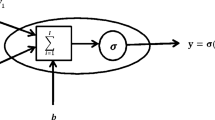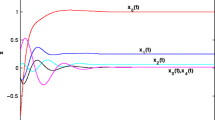Abstract
In this paper, neural networks are used to approximately solve the finite-horizon constrained input H-infinity state feedback control problem. The method is based on solving a related Hamilton-Jacobi-Isaacs equation of the corresponding finite-horizon zero-sum game. The game value function is approximated by a neural network with time-varying weights. It is shown that the neural network approximation converges uniformly to the game-value function and the resulting almost optimal constrained feedback controller provides closed-loop stability and bounded L 2 gain. The result is an almost optimal H-infinity feedback controller with time-varying coefficients that is solved a priori off-line. The effectiveness of the method is shown on the Rotational/Translational Actuator benchmark nonlinear control problem.
Similar content being viewed by others
References
K. Hornik, M. Stinchcombe, H. White. Universal approximation of an unknown mapping and its derivatives using multilayer feedforward networks[J]. Neural Networks, 1990, 3(5): 551–560.
T. Basar, P. Bernhard, H∞ Optimal Control and Related Minimax Design ProblemsA Dynamic Game Approach[M]. Boston: Birkauser, 1995.
A. J. van der Schaft. L 2-gain analysis of nonlinear systems and nonlinear state feedback H∞ control[J]. IEEE Transaction on Automatic Control, 1992, 37(6): 770–784.
A. Isidori, A. Astolfi. Disturbance attenuation and control via measurement feedback in nonlinear systems[J]. IEEE Transaction on Automatic Control, 1992, 37(9): 1283–1293.
J. Huang, C. Lin. Numerical approach to computing nonlinear H∞ control laws[J]. Journal of Guidance, Control, and Dynamics, 1995, 18(5): 989–994.
A. Saberi, Z. Lin, A. Teel. Control of linear systems with saturating actuators[J]. IEEE Transactions on Automatic Control, 1996, 41(3): 368–378.
H. Sussmann, E. D. Sontag, Y. Yang. A general result on the stabilization of linear systems using bounded controls[J]. IEEE Transactions on Automatic Control, 1994, 39(12): 2411–2425.
D. S. Bernstein. Optimal nonlinear, but continuous, feedback control of systems with saturating actuators[J]. International Journal of Control, 1995, 62(5): 1209–1216.
M. Athans, P. L. Falb. Optimal Control: An Introduction to the Theory and its Applications[M]. New York: McGraw-Hill Book Company, 1966.
D. S. Bernstein. Nonquadratic cost and nonlinear feedback control[J]. International Journal of Robust and Nonlinear Control, 1993, 3(3): 211–229.
R. M. Dolphus, W. E. Schmitendorf. Stability analysis for a class of linear controllers under control constraints[J]. Dynamics and Control, 1995, 5(4): 191–203.
A. Saberi, Z. Lin, A. R. Teel. Control of linear systems with saturating actuators[J]. IEEE Transaction on Automatic Control, 1996, 41(3): 368–378.
F. Chen, C. Liu. Adaptively controlling nonlinear continuous-time systems using multiplayer neural networks[J]. IEEE Transaction on Automatic Control, 1994, 39(6): 1306–1310.
S. S. Ge. Robust adaptive NN feedback linearization control of nonlinear systems[J]. International Journal of Systems Science, 1996, 27(12): 1327–1338.
F. L. Lewis, S. Jagannathan, A. Yesildire. Neural Network Control of Robot Manipulators and Nonlinear Systems[M]. Philadelphia: Taylor & Francis, 1999.
M. M. Polycarpou. Stable adaptive neural control scheme for nonlinear systems[J]. IEEE Transaction on Automatic Control, 1996, 41(3): 447–451.
G. A. Rovithakis, M. A. Christodoulou. Adaptive control of unknown plants using dynamical neural networks[J]. IEEE Transaction on Systems, Man, and Cybernetics, 1994, 24(3): 400–412.
R. M. Sanner, J. J. E. Slotine. Stable adaptive control and recursive identification using radial gaussian networks[C] // Proceedings of the 30th IEEE Conference on Decision and Control. New York: IEEE Press, 1991: 2116–2123.
W. T. Miller, R. Sutton, P. Werbos. Neural Networks for Control[M]. Massachusetts, Cambridge: The MIT Press, 1990.
M. Abu-Khalaf, F. L. Lewis, J. Huang. Computational techniques for constrained nonlinear state feedback H∞ optimal control using neural networks[C]//Proceedings of the 12th Mediterranean Conference on Control and Automation. Turkey: Bogazici University, 2004.
M. Abu-Khalaf, F. L. Lewis, J. Huang. Hamilton-Jacobi-Isaacs formulation for constrained input nonlinear systems[C]//Proceedings of the 43rd IEEE Conference on Decision & Control. Piscataway, New Jersey: IEEE Press, 2004: 5034–5040.
M. Abu-Khalaf, F. L. Lewis, J. Huang. Neural network H∞ state feedback control with actuator saturation: the nonlinear benchmark problem[C]//Proceedings of the 5th International Conference on Control & Automation. Piscataway, New Jersey: IEEE Press, 2005: 1–9.
R. Beard. Improving the Closed-Loop Performance of Nonlinear Systems[D]. Troy, New York: Rensselaer Polytechnic Institute, 1995.
R. Beard, T. Mclain. Successive Galerkin approximation algorithms for nonlinear optimal and robust control[J]. International Journal of Control, 1998, 71(5): 717–743.
R. Beard, G. Saridis, J. Wen. Approximate solutions to the time-invariant Hamilton-Jacobi-Bellman equation[J]. Journal of Optimization Theory and Application, 1998, 96(3): 589–626.
F. L. Lewis, M. Abu-Khalaf, J. Huang. Hamilton-Jacobi-Isaacs formulation for constrained input systems: neural network solution[C]//Proceedings of 2nd IFAC Symposium on System, Structure and Control. Plenary Paper, Mexico, 2004: 1–6.
F. L. Lewis, M. Abu-Khalaf. A Hamilton-Jacobi setup for constrained neural network control[C]//Proceedings of the 2003 IEEE International Symposium on Intelligent Control. Piscataway, New Jersey: IEEE Press, 2003: 1–15.
F. L. Lewis, M. Abu-Khalaf, J. Huang. Robust optimal control of constrained input systems using neural networks[C]//Proceedings of 23rd Chinese Control Conference. Shanghai: East China University of Science and Technology Press, 2004: 24–29.
T. Cheng, F. L. Lewis, M. Abu-Khalaf. A neural network solution for fixed-final time optimal control of nonlinear systems[J]. Automatica, 2007, 43(3).
P. Tsiotras, M. Corless, M. Rotea. An L 2 disturbance attenuation solution to the nonlinear benchmark problem[J]. International Journal of Robust and Nonlinear Control, 1998, 8(4–5): 311–330.
B. Chen. Robust and H∞ Control[M]. Berlin: Springer, 2000.
F. L. Lewis, V. L. Syrmos. Optimal Control[M]. New York: John Wiley & Sons Inc., 1995.
M. Abu-Khalaf, F. L. Lewis. Nearly optimal control laws for nonlinear systems with saturating actuators using a neural network HJB approach[J]. Automatica, 2005, 41(5): 779–791.
G. Leitmann. The Calculus of Variations and Optimal Control[M]. New York: Plenum Press, 1981.
C. Huang, S. Wang, K. L. Teo. Solving Hamilton-Jacobi-Bellman equations by a modified method of characteristics[J]. Nonlinear Analysis, 2000, 40(1): 279–293.
M. Bardi, I. Capuzzo-Dolcetta. Optimal Control and Viscosity Solutions of Hamilton-Jacobi-Bellman Equations[M]. Massachusetts: Birkhauser, 1997.
I. W. Sandberg. Notes on uniform approximation of time-varying systems on finite time intervals[J]. IEEE Transactions on Circuits and Systems-I: Fundamental Theory and Applications, 1998, 45(8): 863–865.
R. Beard, G. Saridis, J. Wen. Galerkin approximations of the generalized Hamilton-Jacobi-Bellman equation[J]. Automatic, 1997, 33(12): 2159–2177.
M. J. Balas. Modal control of certain flexible dynamic systems[J]. SIAM Journal of Control and Optimization, 1978, 16(3): 450–462.
B. A. Finlayson. The Method of Weighted Residuals and Variational Principles[M]. New York: Academic Press, 1972.
H. K. Khalil. Nonlinear Systems[M]. Upper Saddle River: Prentice-Hall Inc., 2002.
R. Adams, J. Fournier. Sobolev spaces[M]. 2nd ed. New York: Academic Press, 2003.
J. W. Brewer. Kronecker products and matrix calculus in system theory[J]. IEEE Transactions on Circuits and Systems, 1978, 25(9): 772–781.
V. I. Arnold. Ordinary Differential Equations[M]. Cambridge, Massachusetts: The MIT Press. 1973.
R. Bupp, D. Bernstein, V. Coppola. A benchmark problem for nonlinear control design[J]. International Journal of Robust and Nonlinear Control, 1998, 8(4–5): 307–310.
Author information
Authors and Affiliations
Additional information
This work was supported by the National Science Foundation (ECS-0501451) and Army Research Office (W91NF-05-1-0314).
Tao CHENG was born in P.R. China in 1976. He received his Bachelor’s degree in Electrical Engineering from Hubei Institute of Technology in 1998. He then joined Beijing Polytechnic University from which he received the Master’s of Science in Electrical Engineering in 2001. In 2006 he obtained Ph.D. degree in Automation and Robotics Research Institute from The University of Texas at Arlington. His research interest is in time-varying optimal nonlinear systems, nonholonomic vehicle systems.
Frank L. LEWIS was born in Wurzburg, Germany, subsequently studying in Chile and Gordonstoun School in Scotland. He obtained B.S. degree in Physics, Electrical Engineering and M.S. degree in Electrical Engineering at Rice University in 1971. In 1977 he received the Master of Science in Aeronautical Engineering from the University of West Florida. In 1981 he obtained the Ph.D. degree at The Georgia Institute of Technology in Atlanta, where he had been employed as a Professor from 1981 to 1990 and is currently an Adjunct Professor. Currently he is a Professor of Electrical Engineering at The University of Texas at Arlington.
Rights and permissions
About this article
Cite this article
Cheng, T., Lewis, F.L. Neural network solution for finite-horizon H-infinity constrained optimal control of nonlinear systems. J. Control Theory Appl. 5, 1–11 (2007). https://doi.org/10.1007/s11768-006-6048-5
Received:
Revised:
Issue Date:
DOI: https://doi.org/10.1007/s11768-006-6048-5




